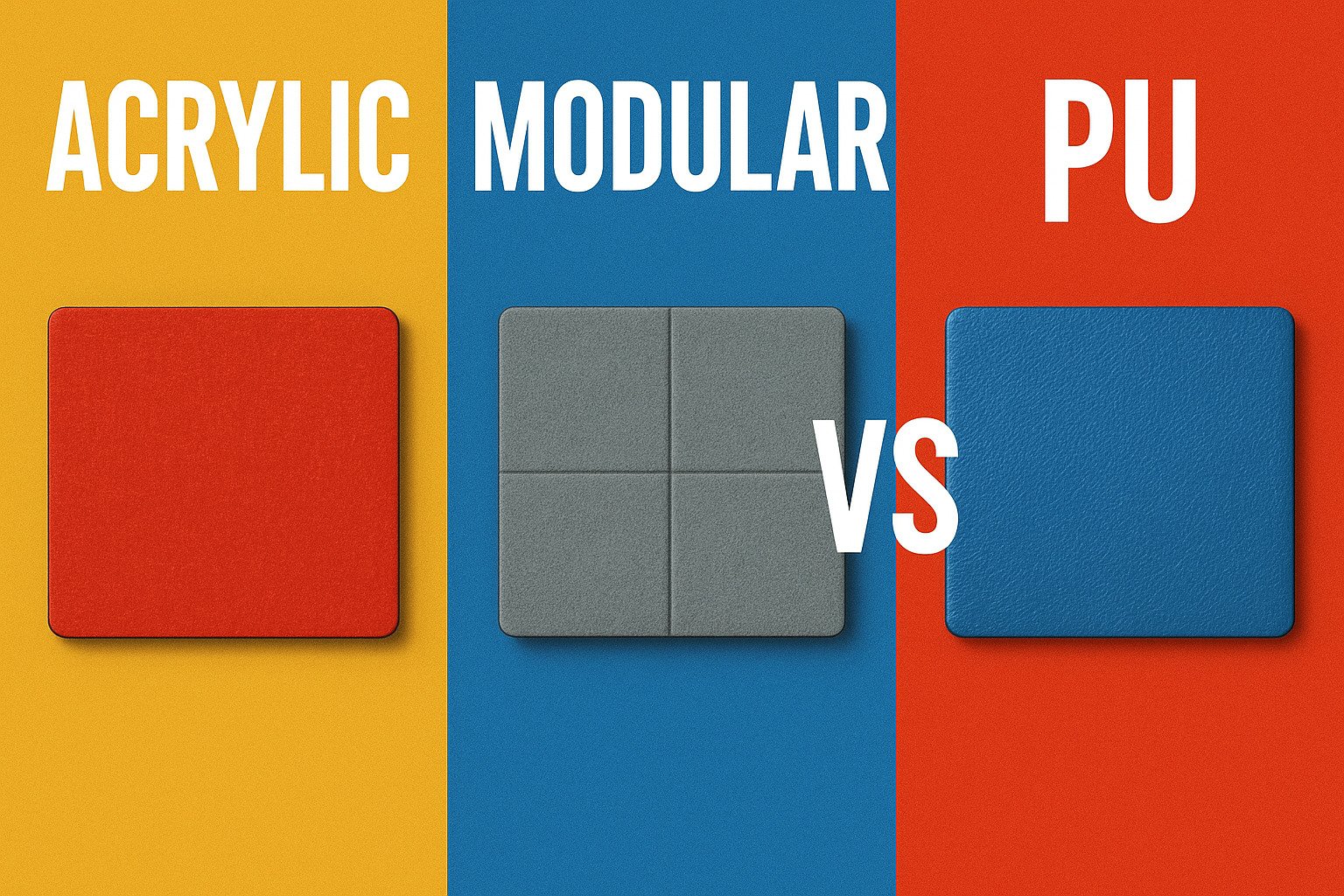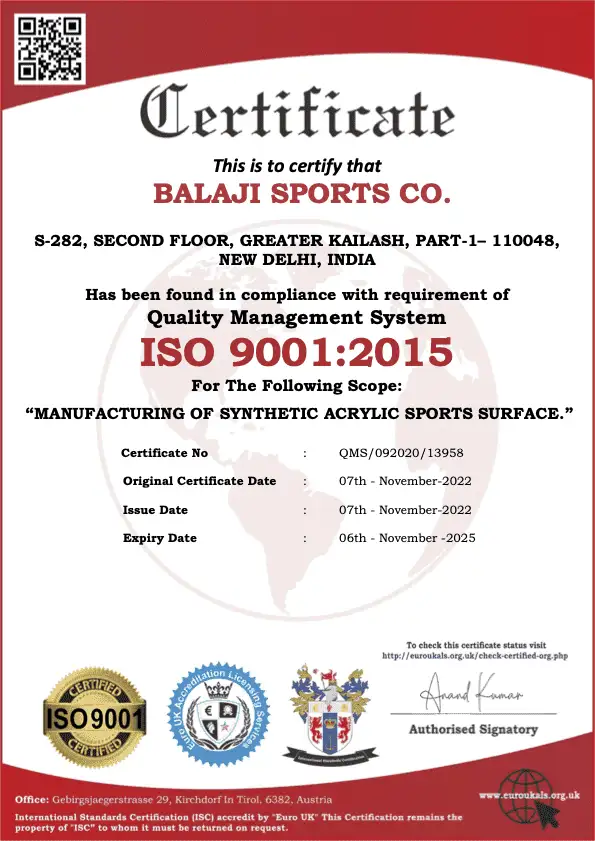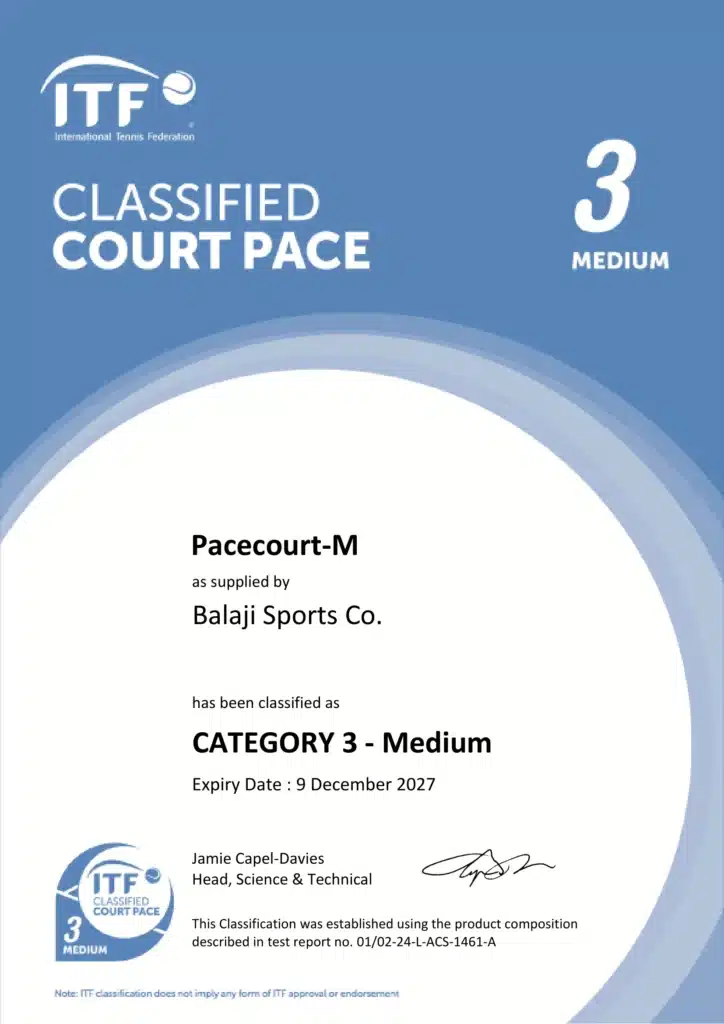
Did you know that 70% of flooring investment decisions in India focus solely on upfront costs, completely ignoring what happens over the next five years? This oversight can lead to expenses that triple your initial budget.
When choosing between Acrylic, Modular Tiles, and PU flooring for your space, the sticker price tells only part of the story. The real financial impact unfolds over years through maintenance costs, replacements, and performance under India’s demanding climate conditions.
India’s diverse weather presents unique challenges that can make or break your flooring investment. From Mumbai’s relentless humidity and coastal salt exposure to Delhi‘s scorching summers and dust storms, from Bangalore’s moderate climate to the Northeast’s heavy monsoons – each region tests flooring materials differently. What performs beautifully in controlled conditions might crack, fade, or deteriorate rapidly under India’s extreme temperatures, seasonal flooding, and year-round dust.
Table of contents
Understanding Total Cost of Ownership (TCO) isn’t just smart – it’s essential for making decisions that protect your investment and deliver long-term value. In this comprehensive analysis, we’ll break down the true costs of each flooring option over five years, factoring in India’s climate realities, so you can choose the solution that makes financial sense for your specific needs and location.
Understanding the Flooring Options

Before diving into cost calculations, let’s examine each flooring type to understand what you’re comparing. Each material brings distinct characteristics that directly impact performance and long-term costs in Indian conditions.
Acrylic Flooring
Acrylic flooring is a synthetic surface made from acrylic resins and polymer compounds. This seamless flooring system creates a durable, non-porous surface that’s gained popularity in India’s commercial and recreational spaces.
Common Applications:
- Sports courts (tennis, basketball, badminton)
- Industrial facilities and warehouses
- Commercial kitchens and food processing units
- Healthcare facilities requiring hygienic surfaces
- Educational institutions with high foot traffic
Pros:
- Weather resistant: Handles temperature fluctuations without cracking
- Low maintenance: Easy to clean with basic equipment
- Customizable colors: Available in multiple shades for aesthetic appeal
- Quick installation: Minimal downtime compared to traditional flooring
- Anti-slip properties: Safer in wet conditions common during monsoons
Cons:
- Higher upfront cost: Premium pricing compared to basic alternatives
- Professional installation required: Not suitable for DIY projects
- Limited repair options: Damage often requires full section replacement
- Heat retention: Can become uncomfortably hot under direct sunlight
Modular Tiles
Modular tiles are interlocking plastic or rubber tiles that snap together without adhesives. These tiles offer flexibility and have become increasingly popular for both indoor and outdoor applications across India.
Common Applications:
- Gym and fitness centers
- Outdoor recreational areas
- Garage and workshop floors
- Temporary event spaces
- Children’s play areas
- Balconies and terraces
Pros:
- Easy DIY installation: No special tools or expertise required
- Replaceable sections: Individual damaged tiles can be swapped out
- Excellent drainage: Raised design prevents water pooling during monsoons
- Portable: Can be relocated or reconfigured as needed
- Shock absorption: Comfortable underfoot for exercise areas
- Chemical resistant: Handles spills and cleaning agents well
Cons:
- Visible seams: Joint lines can collect dirt and debris over time
- Color fading: UV exposure can cause discoloration, especially in bright colors
- Temperature sensitivity: Can expand or contract in extreme weather
- Limited aesthetic options: More functional than decorative
- Potential lifting: Individual tiles may come loose with heavy use
PU (Polyurethane) Flooring
PU flooring is a liquid-applied system that cures into a seamless, flexible surface. This European technology has adapted well to Indian industrial needs, offering excellent chemical and abrasion resistance.
Common Applications:
- Manufacturing facilities and factories
- Pharmaceutical and chemical plants
- Cold storage and food processing areas
- Parking garages and service areas
- Laboratories requiring sterile environments
- High-traffic commercial spaces
Pros:
- Superior chemical resistance: Withstands acids, oils, and solvents
- Seamless finish: No joints for bacteria or moisture to penetrate
- Excellent durability: Handles heavy machinery and constant traffic
- Temperature tolerance: Performs well in extreme hot and cold conditions
- Easy maintenance: Simple cleaning protocols maintain hygiene standards
- Customizable thickness: Can be applied in varying layers based on requirements
Cons:
- Longest installation time: Requires curing periods between coats
- Sensitive to moisture during installation: Monsoon timing affects application
- Professional expertise essential: Improper mixing can cause failures
- Higher material costs: Premium pricing reflects superior performance
- Limited color options: Typically available in industrial color palette
Each flooring type serves specific needs, and understanding these characteristics helps predict their performance and costs over five years in India’s challenging climate conditions.
Key Factors Affecting TCO in Indian Climates

When calculating the true cost of flooring over five years in India, the initial purchase price represents just the tip of the iceberg. Several interconnected factors determine whether your investment delivers value or becomes a financial burden. Understanding these elements helps you make decisions based on long-term performance rather than short-term savings.
Durability Under Extreme Conditions
India’s climate extremes test flooring materials in ways that mild climates never do. Temperature swings from 5°C to 50°C, humidity levels exceeding 90%, and UV radiation intensity that ranks among the world’s highest create a perfect storm for material degradation.
Heat Stress Impact: Thermal expansion and contraction cycles cause different materials to respond uniquely. While PU flooring maintains structural integrity across temperature ranges, modular tiles may develop gaps during extreme heat. Acrylic surfaces can soften under intense sun exposure, affecting performance and appearance.
Moisture Challenges: India’s monsoon season brings prolonged exposure to standing water and high humidity. Materials that absorb moisture risk warping, bacterial growth, and structural failure. The cost of premature replacement due to moisture damage can double your five-year investment.
UV Degradation: Continuous exposure to intense Indian sunlight breaks down polymer chains in flooring materials, leading to color fading, surface chalking, and reduced flexibility. This degradation directly impacts both aesthetics and structural performance.
Maintenance Cost Variables
Maintenance expenses often exceed initial installation costs over five years, making this factor crucial for accurate TCO calculations.
Cleaning Requirements: Each material demands different cleaning protocols. PU flooring requires minimal maintenance with standard cleaning equipment, while modular tiles need regular attention to seam areas where debris accumulates. Acrylic surfaces may need specialized cleaning products to maintain their appearance.
Repair Frequency: Climate-related damage patterns vary significantly. Modular tiles allow easy replacement of individual damaged sections, potentially reducing repair costs. However, seamless surfaces like PU and acrylic may require professional intervention for repairs, increasing both material and labor expenses.
Professional vs. DIY Maintenance: Some materials allow in-house maintenance staff to handle routine care, while others require specialized service providers. This difference can create annual cost variations of ₹50-200 per square meter.
Installation Cost Complexity
Initial installation costs extend beyond material prices to include preparation, labor, and timing considerations specific to Indian conditions.
Weather Window Requirements: Installation timing becomes critical in India’s climate zones. PU flooring requires specific temperature and humidity conditions during application, potentially limiting installation to certain months. This seasonal restriction can affect project timelines and costs.
Surface Preparation Needs: India’s construction standards vary widely, often requiring extensive substrate preparation. Poor foundation work can double installation costs and compromise long-term performance, directly impacting TCO calculations.
Labor Skill Requirements: The availability of skilled installers varies by region and material type. Specialized installations like PU flooring may require bringing technicians from major cities, adding travel and accommodation costs to rural or smaller city projects.
Weather Resistance Performance
India’s diverse climate zones create different stress patterns that affect material longevity and performance costs.
Monsoon Resilience: Heavy rainfall and flooding test drainage capabilities and water resistance. Materials that fail during monsoon seasons require emergency repairs or replacement, creating unexpected costs and business disruption.
Dust and Pollution Tolerance: Urban environments in cities like Delhi and Mumbai expose flooring to high levels of particulate matter and chemical pollutants. Materials that show staining or degradation require more frequent cleaning or refinishing, increasing operational costs.
Thermal Shock Resistance: Rapid temperature changes, especially during pre-monsoon periods, stress material joints and surface integrity. Repeated thermal cycles accelerate wear patterns and reduce overall lifespan.
Aesthetic Longevity Impact
Appearance deterioration affects both functional performance and replacement timing, directly influencing TCO calculations.
Color Stability: UV exposure and chemical interaction cause color changes that may necessitate early replacement for aesthetic reasons, even when structural integrity remains intact. This factor particularly affects customer-facing spaces where appearance standards are non-negotiable.
Surface Texture Changes: Climate exposure can alter surface texture, affecting slip resistance and visual appeal. Changes in texture may also impact cleaning efficiency, increasing maintenance time and costs.
Brand Image Considerations: For commercial spaces, flooring appearance directly affects business image. Accelerated aging due to climate stress may force early replacement to maintain professional standards, regardless of structural condition.
Understanding these factors allows you to weight each material’s strengths and weaknesses against your specific requirements, climate zone, and budget constraints. The next section will translate these factors into concrete cost comparisons across all three flooring options.
Case Studies or Real-Life Examples
Real-world performance data reveals the true impact of flooring choices in India’s diverse climate conditions. These three case studies demonstrate how different materials perform over five years, providing concrete evidence for your decision-making process.
Mumbai Sports Complex: Battling Humidity and Salt Air
The Challenge: A premium tennis academy in Bandra faced unique coastal challenges. The facility needed courts that could withstand 85-90% humidity levels year-round, salt-laden air from the Arabian Sea, and heavy daily usage by 200+ players.
Initial Considerations: The management evaluated all three options. Modular tiles seemed cost-effective initially, but concerns about joint degradation in high humidity led them elsewhere. PU flooring appeared over-engineered for sports applications. They chose acrylic flooring for its proven track record in coastal sports facilities.
The Decision: Premium acrylic flooring system with enhanced UV and moisture resistance, installed across 12 courts at ₹850 per square meter.
Five-Year Outcomes:
- Maintenance Costs: Annual deep cleaning and minor repairs averaged ₹45,000 across all courts
- Performance: Courts maintained consistent ball bounce and player safety standards throughout monsoons
- Aesthetic Quality: Colors remained vibrant with only 15% fade after five years
- Unexpected Benefits: Salt-resistant properties prevented the surface deterioration seen in other coastal facilities
- Total Cost Impact: ₹12.2 lakhs initial investment plus ₹2.25 lakhs maintenance = ₹14.45 lakhs over five years
Key Lesson: The moisture-resistant properties justified the premium cost, as competing facilities using cheaper alternatives required full resurfacing within three years.
Delhi Industrial Warehouse: Surviving Extreme Heat and Dust
The Challenge: A 50,000 square foot pharmaceutical distribution center in Gurgaon needed flooring that could handle forklift traffic, chemical spills, and Delhi’s punishing climate. Summer temperatures reached 48°C inside the non-air-conditioned facility, while dust storms created abrasive conditions.
Initial Considerations: Modular tiles couldn’t provide the chemical resistance required for pharmaceutical storage. Acrylic flooring raised concerns about heat softening and potential contamination issues. PU flooring emerged as the clear choice for its industrial-grade performance.
The Decision: Self-leveling PU flooring system with enhanced chemical resistance, applied at 3mm thickness for ₹420 per square meter.
Five-Year Outcomes:
- Durability Performance: Zero structural failures despite constant heavy machinery traffic
- Temperature Resilience: Surface remained stable even during peak summer heat waves
- Chemical Resistance: Handled cleaning chemicals and minor pharmaceutical spills without staining
- Maintenance Requirements: Monthly industrial cleaning sufficient; no major repairs needed
- Dust Management: Seamless surface prevented dust accumulation in joints
- Total Cost Impact: ₹21 lakhs initial investment plus ₹1.8 lakhs maintenance = ₹22.8 lakhs over five years
Key Lesson: The higher upfront investment in PU flooring delivered exceptional ROI through minimal maintenance needs and zero downtime for repairs.
Bangalore Outdoor Recreation Center: Moderate Climate Success
The Challenge: A community center in Whitefield needed versatile outdoor flooring for basketball courts, children’s play areas, and event spaces. Bangalore’s moderate climate (15-35°C) with distinct wet and dry seasons required a solution that balanced performance with budget constraints.
Initial Considerations: The moderate climate made all three options viable. Budget limitations initially favored modular tiles, while the need for easy reconfiguration for different events supported this choice.
The Decision: High-quality interlocking modular tiles with UV stabilizers, installed at ₹180 per square meter across 8,000 square feet.
Five-Year Outcomes:
- Versatility Success: Tiles were reconfigured 15+ times for different events without damage
- Weather Performance: Excellent drainage during monsoons prevented water damage
- Maintenance Reality: Individual tile replacement needed for 8% of installation due to UV fading
- User Satisfaction: Excellent shock absorption for sports activities
- Color Retention: Noticeable fading in red and blue sections; grey tiles maintained appearance
- Total Cost Impact: ₹1.34 lakhs initial investment plus ₹65,000 replacement tiles and maintenance = ₹1.99 lakhs over five years
Key Lesson: Modular tiles excel in moderate climates where flexibility matters more than premium aesthetics, offering the best value proposition for multi-use spaces.
Comparative Analysis Insights
These real-world examples reveal critical performance patterns:
Climate Adaptation: Each material found its sweet spot – acrylic thrived in humid coastal conditions, PU dominated harsh industrial environments, and modular tiles delivered value in moderate climates.
Maintenance Predictability: PU flooring required the least intervention, while modular tiles needed the most frequent attention but offered easy DIY solutions.
Cost Justification: Higher upfront investments in premium materials often delivered better five-year value through reduced maintenance and replacement needs.
These case studies demonstrate that material selection success depends on matching specific performance characteristics to your unique climate challenges and usage requirements.
Conclusion
Choosing the right flooring for India’s challenging climates requires looking beyond sticker prices to understand the complete financial picture over five years. Our analysis reveals that PU flooring delivers exceptional value in harsh industrial environments, acrylic excels in humid coastal conditions with heavy usage, while modular tiles offer the best cost-effectiveness in moderate climates where flexibility matters.
The key lesson from real-world case studies is clear: materials that cost more upfront often deliver superior long-term value through reduced maintenance, fewer replacements, and consistent performance. A ₹200 per square meter difference in initial cost can easily become a ₹500 savings over five years when you factor in India’s extreme weather conditions.
Your flooring decision should align with three critical factors: your specific climate zone’s challenges, intended usage patterns, and long-term business goals. Don’t let short-term budget constraints drive you toward solutions that will cost significantly more over time.
Ready to make an informed choice that protects your investment? Consult with flooring specialists who understand your local climate conditions and can provide detailed TCO projections for your specific application. Request customized quotes that include five-year maintenance estimates – your future self will thank you for this thorough approach to what may be one of your facility’s most important infrastructure decisions.



